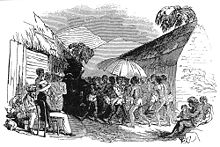
The territory of present day Cameroon was first settled during the Neolithic. The longest continuous inhabitants are groups such as the Baka (Pygmies). From here, Bantu migrations into eastern, southern, and central Africa are believed to have originated about 2,000 years ago. The Sao culture arose around Lake Chad AD 500 and gave way to the Kanem and its successor state, the Bornuempire. Kingdoms, fondoms, and chiefdoms arose in the west.
Portuguese sailors reached the coast in 1472. They noted an abundance of the mud lobster in the Wouri River and named it Rio dos Camarões, Portuguese for “River of Shrimp”, and the phrase from which Cameroon is derived. Over the following few centuries, European interests regularized trade with the coastal peoples, and Christian missionaries pushed inland. In the early 19th century, Modibo Adama led Fulani soldiers on a jihad in the north against non-Muslim and partially Muslim peoples and established the Adamawa Emirate. Settled peoples who fled the Fulani caused a major redistribution of population. The northern part of Cameroon was an important part of the Muslim slave tradenetwork.
The German Empire claimed the territory as the colony of Kamerun in 1884 and began a steady push inland. They initiated projects to improve the colony’s infrastructure, relying on a harsh system of forced labor. With the defeat of Germany in World War I, Kamerun became a League of Nations mandate territory and was split into French Cameroun and British Cameroons in 1919. France integrated the economy of Cameroun with that of France and improved the infrastructure with capital investments, skilled workers, and continued forced labor.
The British administered their territory from neighboring Nigeria. Natives complained that this made them a neglected “colony of a colony”. Nigerian migrant workers flocked to Southern Cameroons, ending forced labor but angering indigenous peoples. The League of Nations mandates were converted into United Nations Trusteeship in 1946, and the question of independence became a pressing issue in French Cameroun.France outlawed the most radical political party, the Union des Populations du Cameroun(UPC), on 13 July 1955. This prompted a long guerrilla war and the assassination of the party’s leader, Ruben Um Nyobe, near Boumnyebel, the village where he was born. In British Cameroons, the question was whether to reunify with French Cameroun or join Nigeria.

Ahmadou Ahidjo arrives at Washington, D.C., in July 1982.
On 1 January 1960 at 2:30 am, French Cameroun gained independence from France under President Ahmadou Ahida. On 1 October 1961, the formerly British Southern Cameroons united with French Cameroun to form the Federal Republic of Cameroon. Ahidjo used the ongoing war with the UPC to concentrate power in the presidency, continuing with this even after the suppression of the UPC in 1971.
His political party, the Cameroon National Union (CNU), became the sole legal political party on 1 September 1966 and in 1972, the federal system of government was abolished in favor of a United Republic of Cameroon, headed from Yaounde. Ahidjo pursued an economic policy of planned liberalism, prioritizing cash crops and petroleum exploitation. The government used oil money to create a national cash reserve, pay farmers, and finance major development projects; however, many initiatives failed when Ahidjo appointed unqualified allies to direct them.
Ahidjo stepped down on 4 November 1982 and left power to his constitutional successor, Paul Biya. However, Ahidjo remained in control of the CNU and tried to run the country from behind the scenes until Biya and his allies pressured him into resigning. Biya began his administration by moving toward a more democratic government, but a failed coup d’état nudged him toward the leadership style of his predecessor.
An economic crisis took effect in the mid-1980s to late 1990s as a result of international economic conditions, drought, falling petroleum prices, and years of corruption, mismanagement, and cronyism. Cameroon turned to foreign aid, cut government spending, and privatised industries. With the reintroduction of multi-party politics in December 1990, the former Bristish Cameroons pressure groups called for greater autonomy, with some (SCNC) advocating complete secession as the Republic of Ambazonia. In February 2008, Cameroon experienced its worst violence in 15 years when a transport union strike in Douala escalated into violent protests in 31 municipal areas.


nice job my dear!
Please keep it up. Our country needs people like us to open it up to the rest of the world.
The 237 team